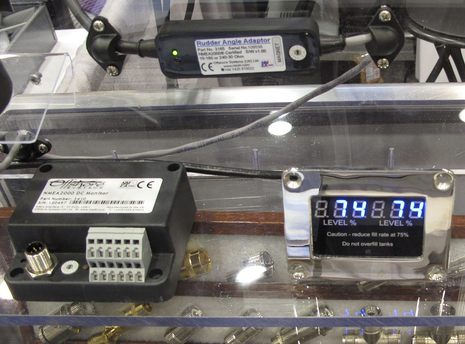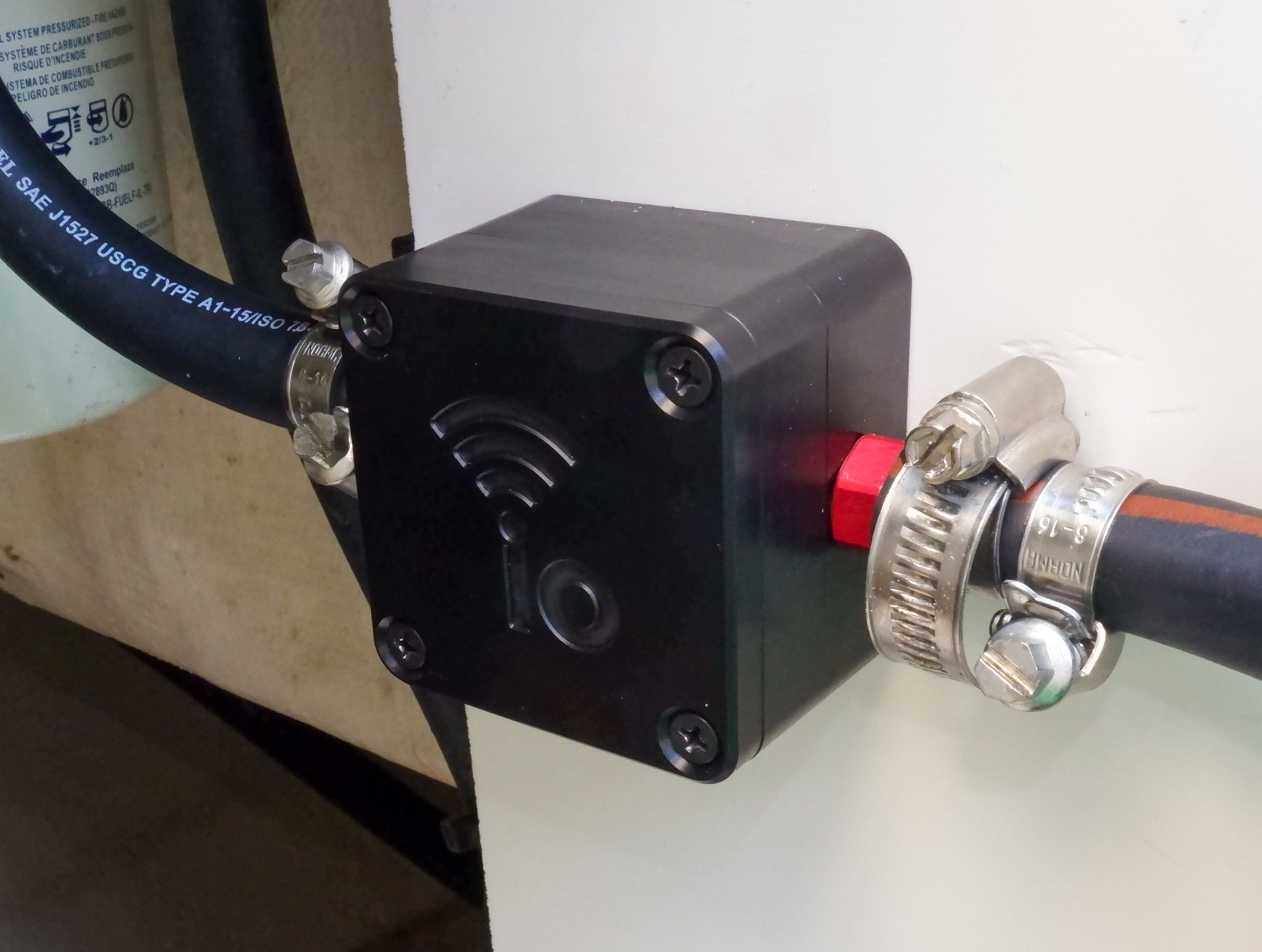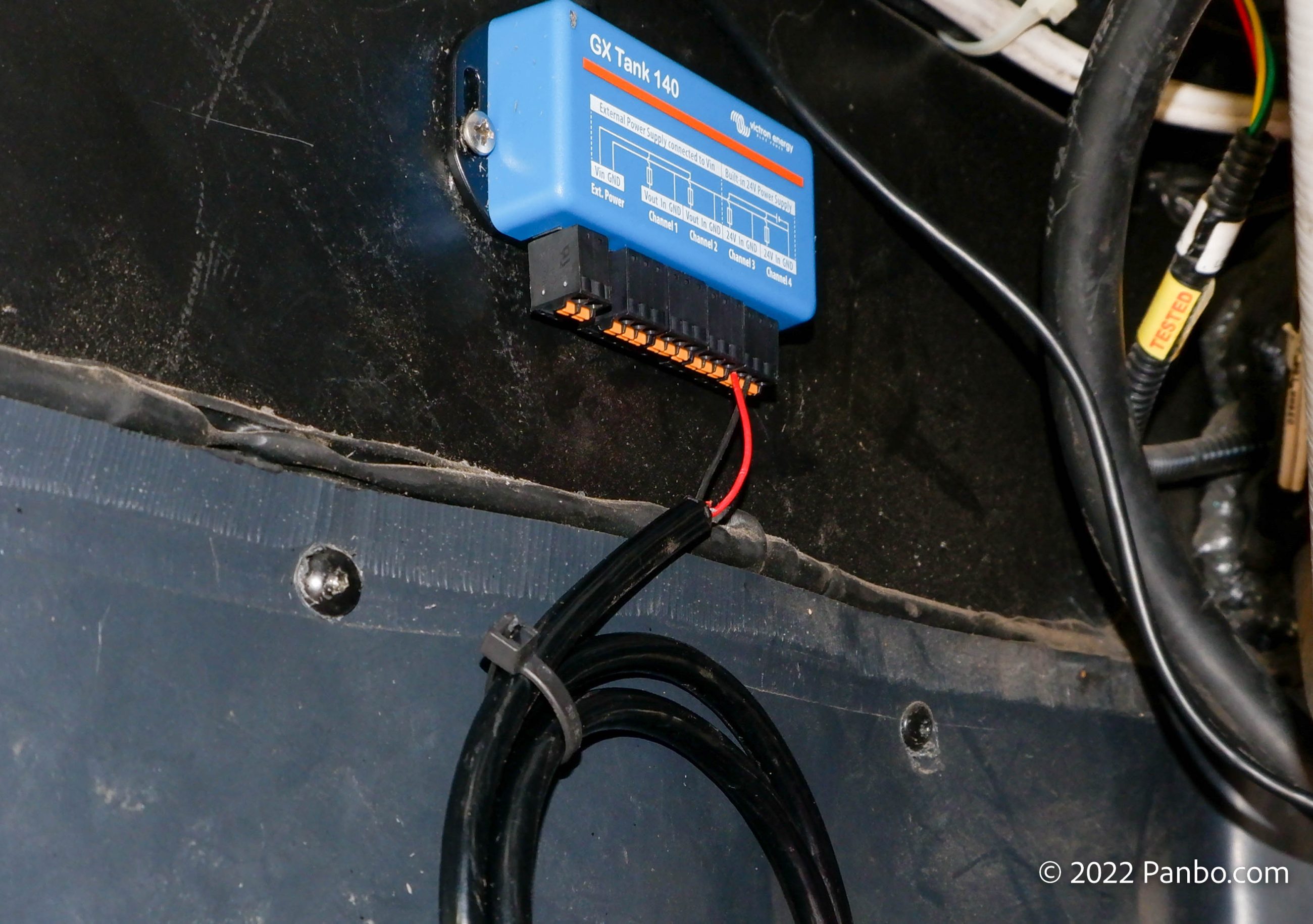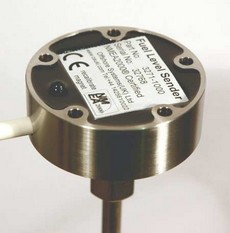Offshore Systems, beyond N2K tank sensors
When we argued recently about how much NMEA 2000 rules inhibit hardware innovation, one success story I thought of was Offshore Systems (UK) Ltd, which developed an interesting N2K solid state tank sensor I first wrote about in 2005. Some 4,000 installations of the 3271 Volumetric Fuel Sender still doesn’t make Offshore a large company, but founder Bruce Coward has continued to create innovative N2K hardware, all of which is both NMEA and CE certified. The photo above shows a few such items seen at IBEX…
At top is the 3165 Rudder Angle Adaptor, which has two features I don’t think you’ll find elsewhere. One is Green and Red port/starboard LEDs that make setting up the actual resistive angle sensor possible without software calibration in a display. And the other — which is common across the Offshore line — is an onboard switch for selecting the N2K “instance”. On a one-rudder boat this would just be left at 0 but if there was a second rudder indicators in use — perhaps to measure mast rotation or some other angle — it would need a different Instance number so that displays could tell the difference.
At lower left in that top photo is Offshore’s new 3410 DC Monitor. I have questions about exactly what sort of current sensors it uses, and wish Offshore would post all its manuals for downloading, but it certainly seems to have all the features of the competitive devices along with some niceties like that Wago “Clamp Cage” terminal block.
Finally, that IBEX display photo also shows Offshore’s 3210 Dual Deck Gauge, which is based on the nifty fill cap display it introduced in 2006. Offshore even makes a non-N2K version these days, and another nuance introduced recently is an Averaging Module for long tanks that can be better tracked with two sensors. Again you can see Offshore’s penchant for built-in instance switching and informative LEDs.
It strikes me that Offshore is something of a poster child for how NMEA 2000 can be used for innovation. But it’s not easy. After all these years, for instance, Offshore gear is still not easy to find. While it’s great news that Offshore Systems is now being wholesaled here in the U.S. by Gemeco Marine Accessories — which has become something of a NMEA 2000 specialist — the more online-retail-style U.S. outlets, like Jamestown Distributors and the NavStore, don’t seem to carry the full line. Being a small N2K hardware innovator is hard, but Offshore Systems keeps plugging along.















So for the tech challenged without enough coffee in the system yet, what does the rudder angle display on?
I’m running a complete 4212 Garmin system.
The Rudder angle (and direction) PGN 127245 displays on some MFDs, many all-in-one instrument displays, and most any autopilot head, even if the associated AP doesn’t need rudder angle to operate. In the case of Garmin I know that both a GMI 10 and GHC 10 will show it.
In fact, I often used a GMI 10 as a full screen analog style rudder angle gauge for Gizmo’s Simrad autopilot last season. The Simrad rudder angle sensor is not N2K but the data is bridged onto SimNet (N2K) in the course computer.
Ben, would you know how they over come the ultrasonic “dead band” issue, where it can’t measure tanks that are either near full or near empty ? Can they really measure as little as a cm of fuel in the tank, and tanks with more than 90% fuel, or did they just overcome sending erroneous signals on those two extremes?
Hard to tell much from the documents that are linked.
That sounds like a trick question, Dan. First of all, who says there is a universal ultrasonic “dead band” issue that effects both high and low readings?
Offshore does make a competitive claim — “No ultrasonic ‘dead band’ which makes it impossible to measure the fuel in the top 75mm or 3 inches of the Fuel tank!” — but I don’t know if it’s true.
So I guess the answer is that Offshore sender technology MAY be able to do something ultrasonic sender technology can’t by not being ultrasonic?
I love the irony of the company called Offshore Systems making N2K gear and N2K is not approved for (commercial)offshore vessels by the IMO only 0183
I love the gear just wish it had serial output
Dead Band & Offshore, nope not a trick question.
I am basing my question on (1) my personal experience with the Maretron product, which gives an undefined reading when the fluid rises to a distance too close for the sensor to read. They have a fix for that with an optional physical cylinder that goes in the tank, which creates an air gap in front of the sensor, but that causes the sensor to report the tank is full early. (2) an industry friends experience using ultrasonic fluid sensors in fuel oil tanks is similar. (As an aside, there are other issues with installing ultrasonic sensors in marine tanks, that are more perplexing than this issue)
For a low tank the issue revolves around the sensor pointing at a bare section of tank, while the tank still has fluid. Normally this is because there was a good reason not to install the sensor over the lowest part of the tank, the boat is heeled, etc. But, rather than showing 0% or some other number, the sensor gives the same undefined value as the sensor provides for a near full tank.
To me this low band issue is remedied if the sensor has a way to know what a full tank is, then undefined can only mean one thing … no fluid under the sensor.
So my question for Offshore, is how did they resolve the the dead band issue? Is it really resolved, or masked? Use an additional sensor along with the ultrasonic sensor to know if tank full? Ultrasonic Sensor has memory so it can remember if the tank was near full or near empty before it reads undefined? Solved by positioning sensor further above tank so sensor is always a necessary distance away from the fluid in a full tank? (but does that require the tank have space above it for a raised sensor?) Did they use a cylinder to capture an air bubble under the sensor, so the liquid stays the necessary distance away ? Or, something in the ultrasonic sensor or supporting electronics does away with the “dead-band”?
Couldn’t figure this out from the links.
Dan, what makes you think that Offshore fluid level sensors use ultrasonic technology? Do you realize that they include a probe that goes nearly to the bottom of the tank? I don’t think they have anything to do with ultrasonic measurement and that’s why Offshore claims they don’t suffer from issues that some ultrasonic sensors may have. I’ll retract “tricky” but replace it with “confusing”.
Meant to note that Offshore also offers a NMEA 2000 to ModBus gateway for big boats. I don’t think ModBus is IMO approved either, of course, because the IMO takes its time with such things.
http://www.osukl.com/3155.htm
Also, when Kees was at METS he heard that Offshore is planning larger displays: http://goo.gl/dftIJ
I believe their fluid level sensor is capacitative. I have one on my rib in my underdeck fuel tank. It needs to ‘learn’ the full and empty positions and then provides fluid level output. It comprises of a hollow stainless probe which has a stainless rod within it isolated by little spacers along its length. You just measure the depth of your tank and cut the probe to length. If connected to one of their head units you can also calibrate it for unusual shaped tanks.
The Simrad autopilot packages ship with a non-Simnet rudder position indicator, but you can easily order a Simnet version which displays nicely on the Maretron DMS250.
Rick, I’m pretty sure that if you put the Maretron display on the same N2K network as the Simrad AP it would see rudder angle regardless of which Simrad rudder sensor is used. That’s because the Simrad course computer bridges analog rudder data onto NMEA 2000.
One thing that doesn’t work, though, is a Maretron rudder adaptor with a Simrad RF300 sensor. Apparently Simrad uses a unusual technique for sending the angle data to the course computer. I’d guess that the Offshore Systems adapter won’t work with an RF300 either, as it only claims compatibility with “standard resistive senders.”
Simrad now uses the RF25.
That is the simnet equivalent of the RF300.
Our senders are capacitive so they really measure from the bottom of the probe right up to the top of the probe so hence “no ultrasonic dead band” is absolutely true.
Cheers, Bruce
Thanks Bruce. In advertising it is not rare to define a products strengths as a weakness of a technology your not using, but it sure is confusing when there is no mention in the description that your product is an orange when your talking about the dead band of the apple.
Hi Dan, I reckon you have a good point there! I thought we defined our units as capacitive and was trying to point out that this avoided the various ultrasonic problems. Cheers, Bruce
NMEA 2000 is approved for commercial offshore ships under the International Electrotechnical Commission (IEC) 61162-3 which was published in 2008. IMO actually references 61162 series which includes the -3 which is NMEA 2000.
I’ve got a Simrad AC42 and RF25 setup and the Rudder data displays nicely on our Maretron DSM250 display (from the RF25 PGN). However, the AC42 continues to transmit the same PGN with 0 or null value (I can’t recall) and no way seemingly to turn it off. There is supposedly a Navico SW Update Tool, anyone familiar with this utility? Thanks.
With the RF300 RPI, you need the autopilot turned on to see the rudder position. With the RF25, it outputs to Simnet directly so the DSM250 will see it without the autopilot.
The fact that one brave soul fought his way through the thicket is a testament to his tenacity and fortitude, not the encouraging nature of the ecosystem.
The real loss are the devices which didn’t get built or software which didn’t get written because of the antics of the N2K Overlords.
That’s called “opportunity cost”. Yes, it’s hard to quantify, but in the world of rapidly moving technology, like that based on Internet and modern electronics technology, it is almost invariably quite high. Best of all, the few times it is not large still count in the win column.
Don’t let the facts get in your way, Mike!
Check out the list recently posted on NMEA’s front page of N2K products certified so far in 2012. I see three companies I’ve never heard of even though I’ve covered this industry pretty closely for over a decade:
Egersund Marine Electronics, http://www.egersundmarine.no
San Giorgio S.E.I.N, http://www.sangiorgiosein.com
Sea Cross Marine AB, http://www.seacross.se
Congratulations to all.
There were also new certifications for Offshore Systems size (I think) companies like AllTek Marine and True Heading, as well for Airmar, Furuno, Icom, Simrad, and Victron.
Mike, if you actually have some factual evidence that N2K hardware isn’t getting built by viable companies because they can’t afford the documentation and certification costs — which are pretty normal for open standards of this type — please take it to the Forum. This entry is trying to be about Offshore.